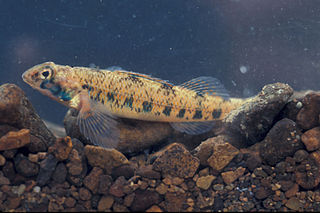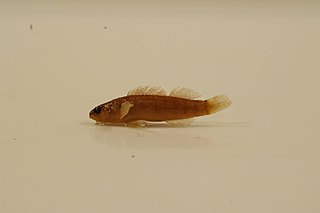
The bluegill, sometimes referred to as "bream", "brim", "sunny", or, as is common in Texas, "copper nose", is a species of North American freshwater fish, native to and commonly found in streams, rivers, lakes, ponds and wetlands east of the Rocky Mountains. It is the type species of the genus Lepomis, from the family Centrarchidae in the order Perciformes.

The johnny darter is a species of freshwater ray-finned fish, a darter from the subfamily Etheostomatinae, part of the family Percidae, which also contains the perches, ruffes and pikeperches. It is native to shallow waters throughout North America east of the Rocky Mountains.

The vermilion darter is a species of freshwater ray-finned fish, a darter from the subfamily Etheostomatinae, part of the family Percidae, which also contains the perches, ruffes and pikeperches. It is endemic to the southern United States, where it only is found in Turkey Creek in Jefferson County, Alabama, part of the Mobile Bay drainage basin. It was first described by Herbert Boschung in 1992, who was the curator of ichthyology at the University of Alabama, along with biologist Richard Mayden and scientific illustrator Joseph Tomelleri. On December 7, 2010, the US Fish and Wildlife Service designated 13 mi (21 km) of Turkey Creek watershed as critical habitat for the darter. According to the IUCN, the population of this fish is declining.

The fantail darter is a species of freshwater ray-finned fish, a darter from the subfamily Etheostomatinae, part of the family Percidae, which also contains the perches, ruffes and pikeperches. It is widely distributed across streams in North America.

The finescale dace is a species of freshwater fish in the family Cyprinidae of order Cypriniformes. It is native to the northern portions of Minnesota, with relatively smaller populations in northern New York, Vermont, New Hampshire, and Maine.

Etheostoma exile, the Iowa darter, is a species of freshwater ray-finned fish, a darter from the subfamily Etheostomatinae, part of the family Percidae, which also contains the perches, ruffes and pikeperches. It is native to the lakes and streams of Iowa, along with about 17 other species of darters.

The mud darter is a species of freshwater ray-finned fish, a darter from the subfamily Etheostomatinae, part of the family Percidae, which also contains the perches, ruffes and pikeperches. It is endemic to the lowlands of the Mississippi River basin from Wisconsin and Minnesota south to Louisiana and East Texas. It is also found in the drainages of the Sabine and Neches Rivers of Texas and Louisiana. It can be found in slow-moving waters on riffles in rivers, as well as in creeks, swamps, lakes, and reservoirs. It mostly consumes the larvae of midges and blackflies. This species can reach a length of 7.1 cm (2.8 in), though most only reach a length of 5 cm (2.0 in).
The corrugated darter is a species of freshwater ray-finned fish, a darter from the subfamily Etheostomatinae, part of the family Percidae, which also contains the perches, ruffes and pikeperches. It is endemic to the eastern United States only known from Caney Fork, Tennessee, where it has been shown to have as many as five subgroups. They are active hunters which prey on insects, fry, and possibly young snails. Multiple species and subspecies of these darters can coexist where substrate is varied, so this must be carefully preserved to accommodate many similar species. With the warming of spring, E. basilare enters its breeding cycle and males develop their dimorphic coloration. Like most darters, it hugs the stream bed, using its body shape and fin posture to maintain its position.

The bluntnose darter is a species of freshwater ray-finned fish, a darter from the subfamily Etheostomatinae, part of the family Percidae, which also contains the perches, ruffes and pikeperches. It is found in eastern North America where it is found in slower moving and still waters.

The swamp darter is a species of freshwater ray-finned fish, a darter from the subfamily Etheostomatinae, part of the family Percidae, which also contains the perches, ruffes and pikeperches. It is endemic to the Eastern United States.

The blueside darter is usually found in the Tennessee River drainage in Tennessee, Alabama, North Carolina, and Virginia, and less commonly found in Bear Creek, Shoal Creek, and Barren Fork.
The stripetail darter is a species of freshwater ray-finned fish, a darter from the subfamily Etheostomatinae, part of the family Percidae, which also contains the perches, ruffes and pikeperches. It is endemic to the eastern United States. It is found in small rivers and streams in the states of Tennessee, Ohio, Kentucky, Illinois, Alabama, Georgia, and Mississippi. Males are a golden-orange color with black barring on the fins, and grow to a length of about 2.8 in (7 cm). This fish feeds on midge larvae and other small invertebrates. It breeds in the spring; eggs are attached to the substrate, often under slab rocks, where they are guarded by the male. The population trend of this fish seems to be stable and it is a common species with numerous sub-populations over a wide range, and the International Union for Conservation of Nature has assessed its conservation status as being of "least concern".
The goldstripe darter is a species of freshwater ray-finned fish, a darter from the subfamily Etheostomatinae, part of the family Percidae, which also contains the perches, ruffes and pikeperches. It is endemic to the southeastern United States where it is found in Gulf Slope streams from the Colorado River drainage in Texas to the Flint River in Georgia, the Atlantic Slope in Ocmulgee River system, Georgia, and the Mississippi embayment north as far as southeastern Missouri and western Kentucky. It is typically found in small springs, streams, and creeks with aquatic and marginal vegetation and detritus. The female spawns on multiple occasions between about mid-March and June, sticking the adhesive eggs to plants, gravel and the sides of rocks. The goldstripe darter is a common species with a wide range and numerous sub-populations, and the International Union for Conservation of Nature has assessed its conservation status as being of "least concern".
The cypress darter is a species of freshwater ray-finned fish, a darter from the subfamily Etheostomatinae, part of the family Percidae, which also contains the perches, ruffes and pikeperches. It is endemic to fresh waters of the central and eastern United States. Its range includes drainages from the Choctawhatchee River, Florida, to the San Jacinto River, Texas, as well as the Mississippi River basin from southern Illinois and eastern Oklahoma to the Gulf of Mexico. It inhabits vegetated margins of swamps and lakes, and backwater habitats during the summer, while in winter it moves to flooded riffles and backwater bayous. It feeds mostly on small crustaceans, as well as insects and their larvae. Spawning takes place during spring and summer, with clusters of up to three eggs being laid, often stuck to the surface of dead leaves. The cypress darter has a very wide range and its population trend seems to be stable. It is a common species with numerous sub-populations, and the International Union for Conservation of Nature has assessed its conservation status as being of "least concern".
The arrow darter is a species of freshwater ray-finned fish, a darter from the subfamily Etheostomatinae, part of the family Percidae, which also contains the perches, ruffes and pikeperches. It is found in parts of Kentucky and Tennessee, particularly in the Cumberland and Kentucky Rivers. These small fish are part of the perch family. They grow to be about 4.5 inches (11 cm) in length. Their opercle, breast, and cheek are all unscaled. They have a vertical black bar at the base of their caudal fin. Six to nine vertical banded bars run down the side of the fish. The dorsal side of the fish is olive green in color, and the ventral side is a yellow to white pattern. The first dorsal fin has a black base, followed by green color, and then a reddish-orange end. The second dorsal is clear with two rows of laterally lined orange spots. The caudal fin is clear and has two-three vertical lines of orange spots. The anal fin has a green base and then clear at the end. The breeding male has bright orange-red spots and breeding tubercles present on the scales.

The Tippecanoe darter is a species of freshwater ray-finned fish, a darter from the subfamily Etheostomatinae, part of the family Percidae, which also contains the perches, ruffes and pikeperches. It is endemic to the eastern United States.

Etheostoma zonale, the banded darter, is a species of freshwater ray-finned fish, a darter from the subfamily Etheostomatinae, part of the family Percidae, which also contains the perches, ruffes and pikeperches. It is endemic to the eastern United States.

The blackbanded darter is a species of freshwater ray-finned fish, a darter from the subfamily Etheostomatinae, part of the family Percidae, which also contains the perches, ruffes and pikeperches. It is native to the river systems of the southeastern United States where it is found in the states of Tennessee, Georgia, Florida, Mississippi, Alabama, and Louisiana. It lives over sandy or gravelly bottoms in smaller rivers and streams and its color varies depending on the different habitats in which it lives. It feeds on small insect larvae and is itself preyed on by larger fish. It spawns between February and June depending on locality. It is generally a common fish throughout most of its range.

The redfin darter is a species of freshwater ray-finned fish, a darter from the subfamily Etheostomatinae, part of the family Percidae, which also contains the perches, ruffes and pikeperches. It is native to the south-central United States, where it occurs in Missouri, Arkansas, Kansas, and eastern Oklahoma.
The lipstick darter is a species of freshwater ray-finned fish, a darter from the subfamily Etheostomatinae, part of the family Percidae, which also contains the perches, ruffes and pikeperches. It is endemic to the eastern United States, where it occurs in the Tallapoosa River drainage above the Fall Line in Alabama and Georgia. It inhabits rocky riffles of creeks and small to medium rivers.















